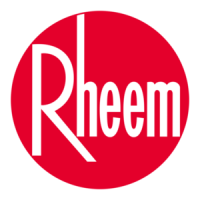28
card and directs the EcoNet
TM
enabled air-handler or
gas furnace control board to deliver an appropriate
indoor air-flow level based on the capacity percentage
required at that point in time. The EcoNet
TM
air-handler
or gas furnace control board will then direct the
variable speed ECM indoor blower motor to start and
operate at the requested heating air-flow level. As the
building load changes throughout the call for heating
operation, the compressor speed, outdoor fan speed,
and indoor air-flow level will respond by ramping up
or down as required to meet the building load exactly
rather than simply cycling on and off as conventional
systems do. Since the noise level of the compressor
increases as speed increases, the maximum allowable
compressor speed in the Overdrive Mode can be
lowered using the EcoNet
TM
Control Center Installer
Menu (RPM Blocking) should the homeowner find
the compressor noise objectionable in the Overdrive
Mode. The current compressor RPM can also be
viewed in the EcoNet
TM
Control Center Service Menu.
When the call for heating has ended, the EcoNet
TM
Control Center will direct the outdoor and indoor units
to shut down. The compressor and outdoor fan motor
will ramp down to zero RPM and the indoor blower
motor will ramp down to the minimum air-flow level for
30-45 seconds to extract the residual heating from the
cold indoor coil before it stops.
6.5 Supplemental Electric
Heat in
Heating Mode
If the building load should exceed the heating capacity
in extreme outdoor conditions, the EcoNet
TM
Control
Center will direct the RHMV air-handler to energize
supplemental electric heat as required to meet the
building load. The indoor air-flow will be forced to
operate at the maximum level for the system. For
13kW heaters and higher, the supplemental electric
heat will be energized in two stages as required. The
compressor and outdoor fan will continue to operate at
maximum capacity while supplemental electric heat is
energized.
6.6 Dual Fuel Applications
–
Heating Mode
If the building load should exceed the heat pump
heating capacity in extreme outdoor conditions, the
EcoNet
TM
Control Center will direct the outdoor unit to
shut down and heating responsibility will be transferred
to the gas furnace. An outdoor ambient temperature
can be set in the EcoNet
TM
Control Center to direct
the system to automatically switch to gas heat when
the outdoor ambient temperature drops below that
set-point. If the EcoNet
TM
Control Center is set to the
EMERGENCY HEAT (Furnace Only) mode, heating
responsibility will be transferred to the gas furnace.
6.7 Demand Defrost
Defrosting of the outdoor coil in the heating mode is
controlled by the Universal Outdoor Control (UODC).
(-)A18AZ/(-)P18AZ outdoor heat pumps utilizes
“demand defrost” that initiates a defrost cycle only
when frosting is detected on the outdoor coil during
heating operation. The UODC continuously monitors
the Outdoor Ambient Temperature Thermistor (OAT)
and Outdoor Coil Temperature Thermistor (EVAPIN)
to determine when a defrost cycle is required. The
following sequence is followed for defrost cycles.
• Defrost Initiation: A defrost cycle is initiated when
the following conditions are met.
1. The outdoor coil temperature is below 35°F
[1.7°C].
2. The compressor has operated for at least
34 minutes with the outdoor coil
temperature below 35°F [1.7°C].
3. The UODC determines a defrost cycle
is required based on the OAT and EVAPIN
temperatures.
If the above conditions are met, the following
action will be taken.
1. The compressor speed is ramped to the
predetermined reversing valve switching
speed for 30 seconds before the reversing
valve is de-energized.
2. The reversing valve is de-energized which
will cause it to shift to the cooling position.
3. The outdoor EXV is driven to the 100%
open position.
4. The outdoor fan motor is de-energized.
5. The indoor air-handler or gas furnace
is directed to supply supplemental heat
to prevent cold air from being discharged
from the supply registers during the
defrost cycle.
6. The compressor speed is ramped to the
pre-determined defrost speed for the
duration of the defrost cycle.
• Defrost Termination: The defrost cycle will
continue until the coil temperature has reached
the termination temperature or 14 minutes have
elapsed, whichever comes first. The factory
default termination temperature is 60°F [15.6°C],
although this temperature can be changed to
40°F [4.4°C], 50°F [10°C], or 70°F [21.1°C] using
dip switches on the UODC (see chart below for
dip switch settings). When the coil temperature
reaches the termination temperature or 14 minutes
have elapsed, the following action is taken.
1. The compressor speed is ramped to the
reversing valve switching speed for 30
seconds before the reversing valve is
energized.
2. The reversing valve will be energized,
switching it back to the heating position.
3. The outdoor fan motor is energized.
4. Auxiliary heat is de-energized.
5. The EXV will return to the normal
superheat control mode.
6. The compressor speed will ramp to a pre-
determined oil circulation speed for 6
minutes.
7. The system returns to normal heating
Operation

